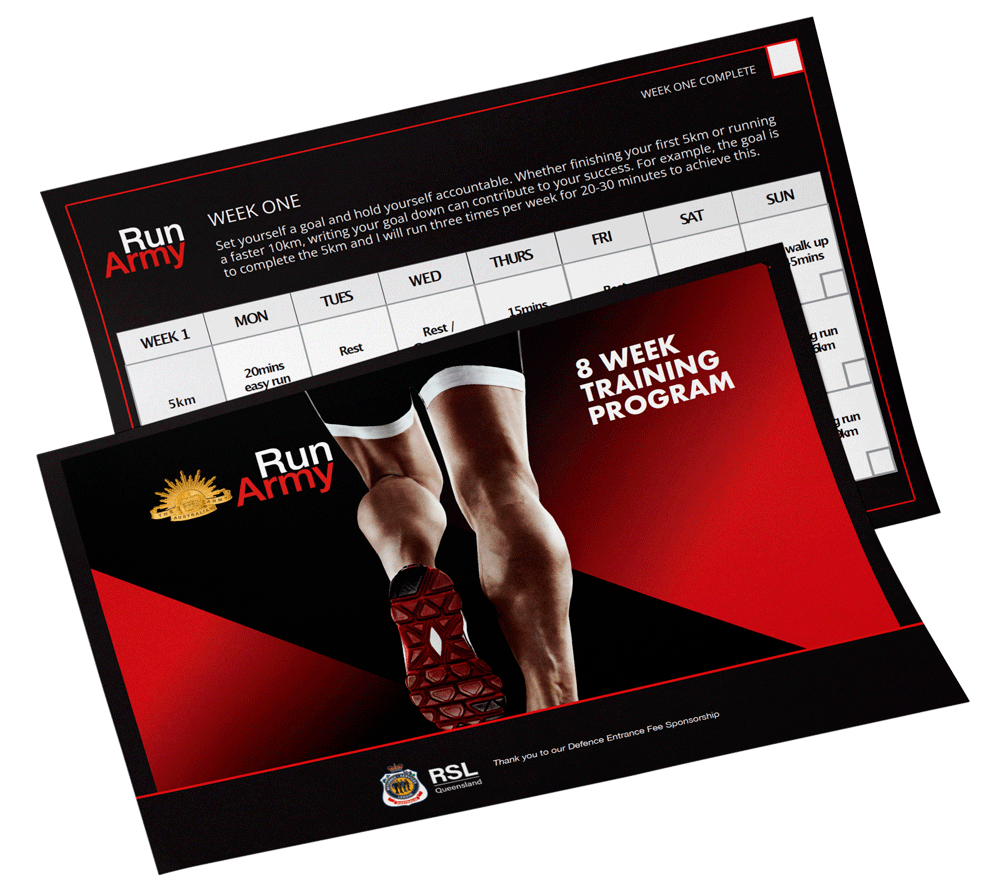Training Programs
On registration, you will receive an 8 week training program to help you with your preparation for Run Army.
The training program is designed to provide you with the guidance to train smartly and safely for either the 5 or 10km event. The program has been designed by Simon O’Regan, the Run Army Technical Advisor who is a Level 2 Athletics Coach and lifetime runner.
Overview
5km
The 5km program is aimed at someone who is new to running or returning after a long absence.
You should be in generally good health and able to walk at a brisk pace for 45-60mins and able to run pain free for 10-15 mins with walk breaks if required.
10km
There will be two 10km options, one aimed at finishing, and one aimed at running faster than you currently run.
The beginner 10km program is aimed at someone who has been exercising regularly and able to run for approx. 20-25 mins at an easy pace.
The advanced program is aimed at someone who has completed 5km and possibly 10km events previously and running 2-3 times a week for at least 30mins.
Key points to remember during training
Injury free
You should be injury free and in generally good health prior to starting the program. Anyone with pre-existing injuries/conditions or commencing exercise after a long absence should consult their GP before commencing this program.
Start slow
Running slow and taking walk breaks is fine and expected depending on what level of fitness you start with.
Less is more
More running is not always better. If you think you should be doing more, engage with a qualified coach or trainer to guide you.
Enjoy the journey
Know that every day you lace up your shoes, you are committing to being better. Enjoy the journey and the rewards that come from training for and meeting goals.
Trust the program
The programs will have a mix of both time and distance. This is intentional – on days where time is prescribed, the distance covered is irrelevant and it is about being on your feet for the time prescribed.
Run slow to get fast
Run slow to get fast. If you read this for the first time, it often does not make sense; however, most people stop running because they are always working hard. Most elite runners spend around 80% of their training running ‘slow’ and a focus on your journey should be a consistency over intensity in the first instance.
Listen to your body
if you are new to running or it has been sometime since regular running, expect some soreness and general fatigue whilst your body adapts. Sharp and consistent pain is not normal and should be reviewed by a health professional.
Be patient
Don’t be too hard on yourself. You should see the program as an opportunity to enjoy your running.
Get the gear
Start the program with good footwear. Engage with a reputable shoe store if your runners are more than 9-12 months old or if you have not run in sometime.
Measure your run
There are several methods to measure the general intensity of your runs (how fast you run) – use the method most appropriate for your situation:
Heart rate
The Running Change program which is a pillar of Run Army utilises the Maffetone system: In its basic form, your easy and long runs are done at a heart rate of no higher than 180 – age. For example, for a 40-year-old this would equal 140 beats per minute (BPM) as the upper limit for your runs with the lower limited being 10 beats below, thus 130 – 140 BPM. This is more accurate if you own a heart rate chest strap as wrist monitors experience some variability. In the absence of a heart rate monitor, the talk test and RPE are effective methods for this program.
Rate of Perceived Exertion (RPE)
A scale from 1 to 10 where 1 is walking and 10 is all out effort. Easy and long runs are completed around RPE 3 – 4 whilst intervals/tempo and fartlek workouts range from 5 to 9.
Talk test
Run at a pace where you can still talk with someone. This is applicable to all easy and long runs.


